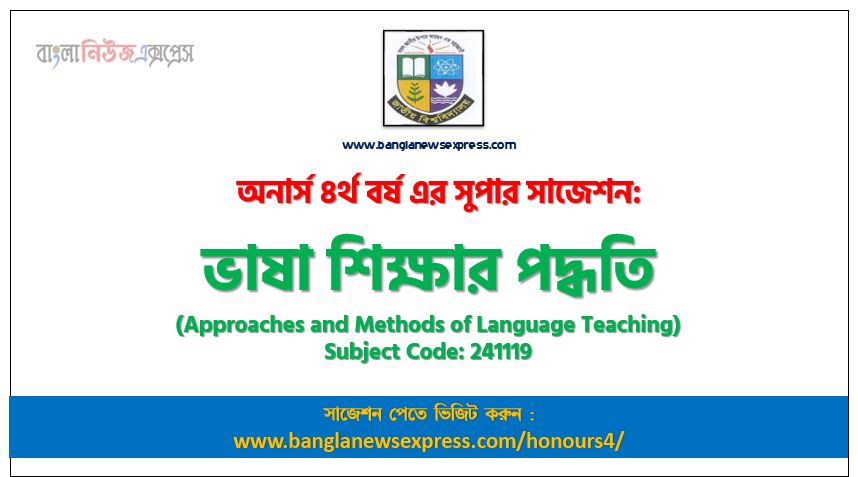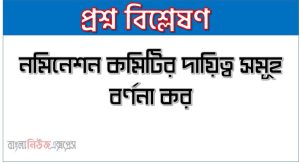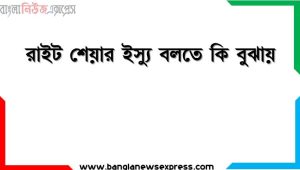Honors 4th Year Approaches and Methods of Language Teaching Suggestion, Approaches and Methods of Language Teaching Suggestion PDF, short suggestion Honors 4th year Approaches and Methods of Language Teaching , Approaches and Methods of Language Teaching suggestion Honors 4th year, Suggestion Honors 4th year Approaches and Methods of Language Teaching ,
Honors 4th Year Approaches and Methods of Language Teaching Suggestion 2025
অনার্স ৪র্থ বর্ষের ভাষা শিক্ষার পদ্ধতি সাজেশন 2025
| জাতীয় বিশ্ববিদ্যালয় অনার্স পাস এবং সার্টিফিকেট কোর্স ৪র্থ বর্ষের BA, BSS, BBA & BSC অনার্স ৪র্থ বর্ষের [২০১৩-১৪ এর সিলেবাস অনুযায়ী] ভাষা শিক্ষার পদ্ধতি ও পদ্ধতি (Approaches and Methods of Language Teaching) সুপার সাজেশন Department of : English & Other Department Subject Code: 241119 |
| ২০২৫ এর অনার্স ৪র্থ বর্ষের ১০০% কমন সাজেশন |
অনার্স ৪র্থ বর্ষের ভাষা শিক্ষার পদ্ধতি ও পদ্ধতি সাজেশন,ভাষা শিক্ষার পদ্ধতি ও পদ্ধতি অনার্স ৪র্থ বর্ষ সাজেশন, চূড়ান্ত সাজেশন অনার্স ৪র্থ বর্ষের ভাষা শিক্ষার পদ্ধতি ও পদ্ধতি, অনার্স ৪র্থ বর্ষের ভাষা শিক্ষার পদ্ধতি ও পদ্ধতি ব্যতিক্রম সাজেশন pdf, অনার্স ৪র্থ বর্ষের ১০০% কমন ভাষা শিক্ষার পদ্ধতি ও পদ্ধতি সাজেশন,
অনার্স ৪র্থ বর্ষের পরীক্ষার সাজেশন ২০২৫ (PDF) লিংক
সর্বশেষ সংশোধিত ও সাজেশন টি আপডেটের করা হয়েছে ২০২৫
Approaches and Methods of Language Teaching Honors 4th Year Suggestion PDF 2025
Part-A : Brief Question with Answers
1. What is ESL?
Ans. ESL stands for English as a second language.
2. What is ‘Applied Linguistics’?
Ans. Applied linguistics is a branch of language study concerned with the scientific study of second and foreign language teaching and learning.
3. Define language from the structural point of view.
Ans. From the structural point of view, language refers to the use of linguistic or grammatical aspects of a language, such as voice sounds, words, and sentences.
4. What is LAD?
Ans. LAD stands for Language Acquisition Device (concerning a part, or parts, of the brain which specialize in the acquisition of language). It is specifically related to the ability of children to learn languages.
5. What is ‘schema’?
Ans. Schema is our background knowledge that helps us understand and interpret information, feelings, and emotions.
6. What is ‘critical period’ in learning language by children?
Ans. “Critical period” is a first Language Acquisition theory which states that children can learn a language first few years of their life very easily, but after puberty, language acquisition rates start dropping and people have hard times to learn a language after 19.
7. What is SLA?
Ans. SLA stands for Second Language Acquisition.
8. What is ‘interlanguage’?
Ans. Interlanguage is a linguistic system that a second language learner makes with a combination of his/her first language and the target language rules or by overgeneralizing some rules of the target language.
9. What is ‘scaffolding’?
Ans. Scaffolding refers to the assistance from an expert to help learners reach next level.
10. What is ZPD?
Ans. ZPD or Zone of Proximal Development is the gap between what a learner can learn by themselves and what he/she can learn with the help of teachers.
11. What is pedagogy?
Ans. Pedagogy is the method and practice of teaching, especially as an academic subject or theoretical concept.
12. What is meant by ‘ELT Methodology’?
Ans. ELT Methodology is a system of practices and procedures that a teacher uses to teach the English Language. It will be based on beliefs about the nature of language, and how it is learnt (known as ‘Approach’).
13. What is ‘approach’ in language teaching?
Ans. According to Anthony (1963:63-7): “An Approach is a set of correlative assumptions dealing with the nature of language teaching and learning.”
14. Define ‘Direct Method’.
Ans. Direct Method is a language teaching approach in which students are taught the target language without translation into the native language.
15. Which method is known as the ‘classical method’?
Ans. Grammar-Translation Method is known as the classical method.
16. What is the medium of instruction in the GTM?
Ans. The first language of the learners is the medium of instruction in the GTM.
17. What is GTM?
Ans. GTM is a teaching method where teachers teach grammatical rules to students, and students memorize rules to translate sentences and passages from mother tongue into the target language and vice versa.
18. What are audio-lingual drills?
Ans. Audio-lingual drills mean practising some target language structures over and over to be trained or conditioned to use them in real life situations.
19. What does Audio-Lingual Method mean?
Ans. The Audio-lingual Method is a method for foreign language teaching which emphasized the teaching of listening and speaking before reading and writing.
20. What does the ‘Army Method’ refer to?
Ans. The Army Method refers to the drilling and intensive practice of structures of the target language.
21. What is CLT?
Ans. Communicative language teaching is a language teaching approach that focuses on the communicative competence in a language.
22. What is TPR?
Ans. “Total Physical Response” means students physical response to commands in the target language.
23. What is the goal of TPR?
Ans. To provide an enjoyable learning experience, having a minimum of the stress that typically accompanies learning a foreign language.
24. What is “method”?
Ans. A method is the reflection of a chosen approach to teaching and learning.
25. What is the oldest ‘Language Teaching Method’?
Ans. The oldest “Language teaching method” is called Grammar Translation Method.
26. What is TBLT?
Ans. TBLT (Task Based Language Teaching) is a classroom activity that focuses on meaning through which learners understand and produce the target language while performing a set of steps.
27. How many phases are there in TBLT?
Ans. There are three phases in TBLT.
28. What does CLIL refer to?
Ans. CLIL refers to learning a language through cross-curricular contents such as science, history, etc.
29. What are BANA and TESEP?
Ans. The approaches to language teaching and learning used in Britain, Australia and North America (Kachru’s inner circle) are called BANA.
The teaching approaches followed in the rest of the world are called TESEP.
30. What is IPA?
Ans. The International Phonetic Alphabet (IPA) is an alphabetic system of phonetic notation devised by the International Phonetic Association as a standardized representation of the sounds of oral language.
| Honors Suggestion Links | প্রশ্ন সমাধান সমূহ |
| Degree Suggestion Links | BCS Exan Solution |
| HSC Suggestion Links | 2016 – 2025 জব পরীক্ষার প্রশ্ন উত্তর |
| SSC Suggestion Links | বিষয় ভিত্তিক জব পরিক্ষার সাজেশন |
Approaches and Methods of Language Teaching Suggestion PDF 2025
Part B : Short Questions
1. Distinguish between Acquisition and Learning.
2. Why should a teacher know the theories of language teaching methods?
3. What are the goals of the Grammar Translation Method?
4. In which situation would the use of the GTM yield success?
5. What are the goals of the direct Method?
6. What is the teachers role in the Direct Method?
7. What are the fundamental differences between the Audio Lingual Method and the ‘Direct Method’?
8. Mention the salient/common teaching techniques used in the Audio-Lingual Method.
9. Mention the role of the teachers and the students in the Audio Lingual Method.
10. What are the goals and the principles of the Audio-Lingual Method?
PDF Download ভাষা শিক্ষার পদ্ধতি অনার্স ৪র্থ বর্ষ সুপার সাজেশন 2025
11. What are the main techniques of CLT?
12. What is the role of a teacher in CLT?
13. What are the difficulties in implementing CLT in the classroom?
14. Define ‘communicative competence’.
15. What are the principles of CLT?
16. What are the basic differences between CLT and GTM?
17. Write about the principles of Task-based Language Teaching.
18. What is meant by ‘Post Method Pedagogy’?
19. What is a ‘contextual approach to teaching’? How does it affect pedagogy?
20. What is meant by tissue rejection’ in language teaching methodology?
21. What are the characteristics of a good language learner?
22. Distinguish between ‘intensive’ and ‘extensive’ reading.
23. What are challenges of using literature in ESL Classroom?
24. Do you think English is a threat to other languages?
25. How can synonyms and antonyms be used in teaching vocabulary?
26. What are the basic levels of listening?
27. What are the main listening materials?
28. What are the main problems in teaching language in a large class?
29. The Monitor.
30. Grammar-Translation Method.
31. Direct Method.
32. What are the Macro and Micro writing skills?
33. What is ‘Critical Period’?
34. What are the purposes of teaching vocabulary?
35. Discuss the major strategies and techniques of developing vocabulary.
36. Write a short note on ‘Affective-Filter Hypothesis’.
Part C : Broad Questions
[ বি:দ্র: উত্তর দাতা: রাকিব হোসেন সজল ©সর্বস্বত্ব সংরক্ষিত (বাংলা নিউজ এক্সপ্রেস)]
1. Discuss the structural, functional and interactional views of language.
2. Evaluate the main principles of the behaviourist theory of language acquisition or learning.
3. Discuss and evaluate the five hypotheses of Krashen’s Monitor Model. Do you agree with Mclaughlin that Krashen’s Theory is seriously flawed in many respects?
4. Briefly discuss innatism.
5. Make a comparative study of the Behaviourist Theory and the Mentalist Theory of L1 Acquisition.
6. Give a historical overview of Language Teaching Methodology.
7. Evaluate the Grammar Translation Method focusing on its main characteristics, strengths and weaknesses.
8. What are the main techniques associated with the GTM?
9. What are the key features and techniques of the Direct Method? What are its advantages and limitations?
10. What is the Direct Method? Compare and contrast the GTM and the Direct Method.
11. What are the goals and principles of the Audio-Lingual Method? Discuss its advantages and disadvantages.
12. What is Situational Language Teaching (SLT)? Discuss the approach, design and procedures of Situational Language Teaching.
13. Discuss the main principles of the Communicative Language Teaching. Why is CLT considered an approach rather than a method?
14. What are the roles played by the learners and the teachers in CLT?
15. Elucidate the limitations/ challenges of implementing CLT for language teaching in Bangladesh.
16. Discuss the main concerns and the procedures of the Natural Approach in Teaching four skills. What are the four basic stages of SLA mentioned in the Natural Approach?
17. What is Task-Based Language Teaching (TBLT)? Discuss the theoretical principles, chief features and stages of TBLT.
অনার্স ৪র্থ বর্ষের ১০০% কমন ভাষা শিক্ষার পদ্ধতি সাজেশন 2025
18. State the theoretical foundation (main principles) of Total Physical Response? What are its advantages and disadvantages?
19. What is Task-based Language Teaching? Discuss the types of. tasks with special reference to Focused Tasks.
20. What is “post-method pedagogy”? discuss the strategic framework proposed by B. Kumaravadivelu?
21. Discuss the major strategies and techniques of developing Vocabulary.
22. What are the roles of a teacher in a language teaching class room?
23. What are the merits and demerits of using literature in ELT classroom?
24. Define Linguistic Imperialism. Discuss the role of English Language Teaching in Linguistic Imperialism.
25. What are the social and psychological factors that play in Acculturation Model of second language development?
26. Evaluate the role of the Reform Movement in the history of English Language Teaching focusing on the principles of the Reform Movement.
27. Discuss the chief characteristics of Communicative Language Teaching.
28. Compare Audio-Lingual Method with Communicative Language Teaching.
29. What is meant by ‘Desuggestopedia’? Identify the objectives, main principles and key features of ‘Desuggestopedia’ and evaluate their relevance to the main stream Bangladeshi classrooms.
30. What are the different ways of teaching grammar? Discuss.
31. Discuss the importance of ‘pair work’ and ‘group work’ in a language classroom.
32. What are the ways of improving writing skills?
33. State the role of students in different methods.
34. What is Kumaravadivelu’s concept of the post Method Pedagogy? Do you think that the post method pedagogy is required to deal with the contemporary challenges of English Language Teaching?
২০২৫ জাতীয় বিশ্ববিদ্যালয়ের এর 2025 অনার্স ৪র্থ বর্ষের ভাষা শিক্ষার পদ্ধতি পরীক্ষার সাজেশন, 2025 অনার্স চতুর্থ বর্ষ ভাষা শিক্ষার পদ্ধতি সাজেশন
Honors 4th year Common Suggestion 2025
আজকের সাজেশস: অনার্স ৪র্থ বর্ষের ভাষা শিক্ষার পদ্ধতি স্পেশাল সাজেশন 2025,Honors Approaches and Methods of Language Teaching Suggestion 2025
PDF Download ভাষা শিক্ষার পদ্ধতি অনার্স ৪র্থ বর্ষ সুপার সাজেশন, ভাষা শিক্ষার পদ্ধতি অনার্স ৪র্থ বর্ষ সাজেশন পিডিএফ ডাউনলোড, ভাষা শিক্ষার পদ্ধতি সাজেশন অনার্স ৪র্থ বর্ষের, অনার্স ৪র্থ বর্ষ ভাষা শিক্ষার পদ্ধতি সাজেশন, ভাষা শিক্ষার পদ্ধতি অনার্স ৪র্থ বর্ষ সাজেশন,






